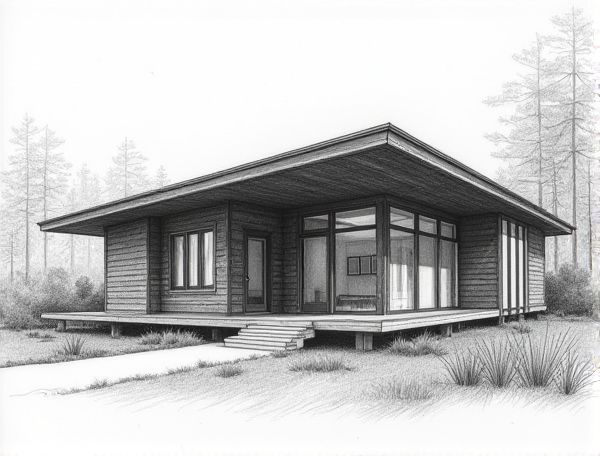
Photo illustration: Shou Sugi Ban home design with charred cedar siding
Shou Sugi Ban home design uses charred cedar siding to provide a durable, fire-resistant, and visually striking exterior that naturally repels pests and resists weathering. Explore this innovative technique further to discover how Your home can benefit from its unique blend of tradition and modern aesthetics. Read more in the article.
Introduction to Shou Sugi Ban Home Design
Shou Sugi Ban home design showcases the ancient Japanese technique of preserving wood by charring its surface, creating a striking contrast of deep, textured grain and natural durability. Your living space benefits from this eco-friendly method that enhances wood's resistance to weather, insects, and fire while adding a unique, elegant aesthetic.
History and Origin of Charred Cedar Siding
Charred cedar siding, known as Shou Sugi Ban, originated in Japan over 300 years ago as a traditional method for preserving wood by charring its surface to enhance durability and resistance to insects and fire. This technique involves carefully burning the cedar planks until the surface chars, creating a protective layer that also showcases a distinctive dark finish prized in modern architectural designs. Today, charred cedar siding is celebrated for its sustainability, longevity, and unique aesthetic, blending ancient craftsmanship with contemporary home design trends.
Benefits of Shou Sugi Ban in Modern Architecture
Shou Sugi Ban enhances modern architecture by providing naturally durable, fire-resistant cladding that reduces maintenance costs and extends the lifespan of exterior surfaces. Its carbonized wood offers a unique aesthetic appeal with rich textures and deep blacks, complementing minimalist and contemporary design styles. The method's eco-friendly properties, including the use of sustainable cedar wood and chemical-free preservation, support green building initiatives and sustainable home design.
Unique Aesthetic Appeal of Charred Wood Exteriors
Charred wood exteriors, created through the traditional Japanese technique of Shou Sugi Ban, offer a unique aesthetic appeal by combining deep, textured blackened surfaces with enhanced durability and resistance to weather and pests. This distinctive finish not only highlights natural wood grain patterns with rich contrasts but also provides a sustainable and low-maintenance option for modern home designs.
Durability and Weather Resistance of Charred Cedar
Charred cedar offers exceptional durability and weather resistance, making it an ideal choice for your home's exterior. Its unique carbonized layer provides natural protection against moisture, insects, and UV damage, ensuring long-lasting performance. This weather-resistant wood maintains structural integrity and aesthetic appeal even in harsh climates.
Eco-Friendly Aspects of Shou Sugi Ban Siding
Shou Sugi Ban siding offers exceptional durability and natural resistance to pests, fire, and rot, making it an eco-friendly choice for sustainable home design. This traditional Japanese technique involves charring the wood surface, reducing the need for chemical treatments and enhancing longevity. Incorporating Shou Sugi Ban ensures your home benefits from a low-maintenance, environmentally conscious exterior solution that aligns with green building practices.
Design Versatility: Shou Sugi Ban in Contemporary Homes
Shou Sugi Ban offers unparalleled design versatility by seamlessly blending traditional Japanese charred wood techniques with contemporary architectural styles, enhancing Your home's aesthetic and durability. Its natural resistance to weather, pests, and fire makes it an eco-friendly, low-maintenance choice for modern interior and exterior applications.
Maintenance Requirements for Charred Cedar Siding
Charred cedar siding requires minimal maintenance due to its natural resistance to rot, insects, and weather damage, preserving its durability and aesthetic appeal over time. Periodic inspection and gentle cleaning with water and a soft brush help maintain its protective layer and prevent buildup of debris or mold.
Cost Considerations for Shou Sugi Ban Home Projects
Shou Sugi Ban home projects typically incur costs related to high-quality cedar wood, labor-intensive carbonization processes, and specialized finishes that enhance durability and fire resistance. Budgeting must also account for maintenance expenses over time, as the unique charring technique requires periodic inspection to preserve its aesthetic and protective properties.
Inspiring Shou Sugi Ban Home Design Ideas
Shou Sugi Ban, a traditional Japanese wood-burning technique, enhances your home design with striking, charred wood textures that resist weather and pests. This method creates a unique, modern aesthetic while providing long-lasting durability and low maintenance for exterior cladding. Incorporating Shou Sugi Ban adds an authentic, visually captivating element to your living space, blending natural beauty with sustainable practices.
 homedesy.com
homedesy.com